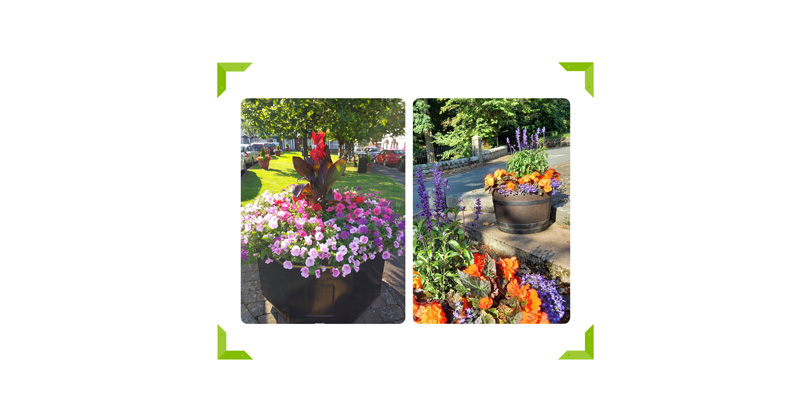
11 April 2025 | Amberol Ltd
How to sustain and attract wildlife in your community garden this spring
Spring is one of our favourite seasons at Amberol. It’s the time of year we begin to see snowdrops make way for daffodils and early bluebells – but it’s also a time for preparation.
The gardeners among us will be busy potting, plotting, and planting ahead for the floral displays that will spread through the nation this summer.
With sustainable gardening on the minds of many this year, why not consider ways we can plant beautiful blooms whilst sustaining and attracting wildlife?
For those involved in Britain in Bloom competitions, or community gardeners planning floral displays for a local Railway 200 event, creating a sustainable environment for pollinators and the public alike could be a source of inspiration. However big or small your community garden, there are plenty of ways to make the most of this season.
We’ve compiled a few spring gardening ideas that combine beauty with sustainability to get you inspired this spring.
Planting pollinator corridors
Is there an unused patch of ground in your community garden or local greenspace? If so, why not consider sowing a wildflower patch?
The benefits of planting wildflowers such as lavender, foxglove, bluebells, wood anemone and milkweed are not only aesthetic - they also provide essential nutrients to pollinators such as butterflies and bees. It’s also an easy way to create a more vibrant ecosystem within urban landscapes.
With brighter weather in our midst, it’s as easy as finding a wildflower or meadow seed mix and sowing them in a sunny spot – either directly into the ground or into containers if space is limited.
Come early summer, both pollinators and passersby will delight in the vibrant blooms.
Small space and urban gardening
For those with limited outdoor space, there are still plenty of ways to get creative with your gardening.
Vertical gardens offer a huge array of options including flowers, fruits, or even green ‘living’ walls that can transform bare surfaces into flourishing displays.
Container gardening is also a versatile option for flowers or vegetables that require a bit more management as you can always move the planters into the shade if needed.
With just a few steps, you can transform your bare courtyard into an urban oasis.
Edible gardens
Why not consider integrating a vibrant flower border with edible plants such as kale or carrots this spring? The mixture of textures and colours will not only look fantastic but ultimately help build a community garden that is both sustainable and visually pleasing.
For those with limited outdoor space, planting crops in containers is an effective way to start your edible garden – and could be especially delightful for young people to get involved with. However, it’s best to plan for the type of crops that will go in the planters as some will need more space for their roots to grow.
Hanging baskets are suitable for crops such as strawberries and tomatoes, whilst window or barrier boxes are a good fit for salads and leaves with shallow roots, and deeper and wider planters are a great option for potatoes.
Amberol’s self-watering planter range is ideal for growing vegetables, since the dispersal matting distributes water evenly to the compost overlaying it, always keeping it moist. For larger fruit trees or shrubs, try one our Large Floor Standing Planters.
Conserving water in a warming climate
Hot spells during the late spring and summer months can affect how well the plants in your garden grow. They may also require a lot more water to sustain, which can have a knock-on effect on wildlife. While it’s a good idea to select hardy plants that can weather a warmer climate, there are other ways to conserve water whilst making sure your flowers, fruit or vegetables thrive. Laying mulch around your garden can help soil retain moisture and ultimately reduce the amount of time spent watering.
If you are planting in containers, this is where the self-watering feature of Amberol planters can really make a difference to the health of your plants and wildlife. Proud originators of the Aquafeed™ self-watering system, our low-maintenance planter range features capillary matting that frees up users to water plants only once or twice a week – saving time, water, and money.
Unlike other materials such as terracotta or metal which easily dry out, expand and crack, all our products are made using a long-lasting durable polyethylene material that can withstand hot and cold temperatures, which makes it ideal for flowers and foliage. They are also 100% recyclable at the end of use, with black products made of recycled polyethylene.
Vibrant colours and unusual plants
Amberol customers are no strangers to vibrant floral displays. Take some time browsing through the stunning displays that have bloomed in Amberol planters over the years in our customer photo gallery.
Wherever you are on your community gardening journey, here are some unique blooms to consider planting this spring:
• Epimedium
• Primula aurantiaca
• Marsh woundwort
• Snowdrift
• Snapdragon vine
Amberol can support your community gardening project
Amberol products have long formed an important part of many community projects, including Britain in Bloom finalists and winners over the years. Our products are sustainable by design using recycled or recyclable materials, and our self-watering planters help conserve water and reduce maintenance demands.